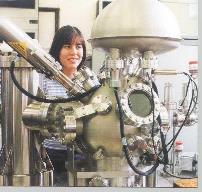Staff profile
Professor Jas Pal Badyal
Professor
FRS

| Affiliation | Telephone |
|---|---|
| Professor in the Department of Chemistry | +44 (0) 191 33 42001 |
Biography
BIOGRAPHY
Place of Birth: England, UK
Cambridge University:
- BA/MA Natural Sciences (1982–85)
- PhD Surface Science (1985–1988)
Durham University:
- Lecturer (1989–1996)
- Full Professor (1996–present)
Awards and Prizes:
- King's College Fellowship, Cambridge University (1988–1989)
- Oppenheimer Fellowship, Cambridge University (1988–1989)
- 1993 Harrison Prize and Medal for Most Meritorious and Promising Original Investigations in Physical/Theoretical Chemistry, the Royal Society of Chemistry
- 1995 Burch Prize for Outstanding Work in the Field of Surface Science, The British Vacuum Council (Institute of Physics and the Royal Society of Chemistry)
- 2016 Elected Fellow of the Royal Society (FRS)—UK and Commonwealth National Academy of Sciences
- 2017 Tilden Prize and Medal for Advances in Chemistry, the Royal Society of Chemistry
- 2018 Chemical Research Society of India Medal
- 2018 The UK’s Best Breakthroughs List—100 most significant breakthroughs to come from UK universities (Universities UK, the umbrella organisation for UK universities)
- 2019 Elected Foreign Fellow of the National Academy of Sciences, India
WATCH THE IMPACT OF OUR RESEARCH

- Video: Half a billion smartphones protected from water damage using functional surfaces (Patented invention by PhD student Stephen)
- Video: A smart mesh for clean water and preventing the spread of antimicrobial resistance (Patented invention by PhD student Angus and Masters student Olivia)
- Video: International collaboration: Trailer for global release of The Garden of Secrets documentary--bioinspired surfaces for environmental sustainability and tackling climate change (World premiere at Cooper Hewitt Smithsonian Museum, Madison Avenue, New York, USA)
- Video Bioinspired water collection surfaces for sustainable architecture design (Patented invention by Masters student Rowan)
RESEARCH TOPICS
Functional Surfaces and Surface Science
Designing functionalised surfaces forms the basis of a multi-billion dollar global industry. For example, the cleanliness of optical lenses, the resistance of biomedical devices to bacteria, the speed of computer hard disks, and even the wear of car brake pads are all governed by their surface chemistry. We are interested in devising novel functional surfaces for commercial applications and to help alleviate poverty in developing countries (clean drinking water, solar harvesting, etc). Current topics of investigation include:

UNITED NATIONS 2030 SUSTAINABLE DEVELOPMENT GOALS
Our research is helping to address the following UN 2030 Sustainable Development Goals:
- Goal No 1: No Poverty
- Goal No 3: Good Health and Well Being
- Goal No 4: Quality Education
- Goal No 5: Gender Equality
- Goal No 6: Clean Water and Sanitation
- Goal No 7: Affordable and Clean Energy
- Goal No 9: Industry, Innovation, and Infrastructure
- Goal No 11: Sustainable Cities and Communities
INDUSTRY AND START-UP COMPANIES
Many of these projects involve collaboration with industry. In addition, the following start-up companies have successfully commercialised patented research from Professor Badyal's laboratory:
- Surface Innovations Ltd
- Dow Corning Plasma Ltd (Invexus)
- P2i Ltd (2015 International Business Award for 'Most Innovative Company in Europe')
TEACHING
- Learn more about functional surfaces--specialist tutorials:
SAMPLE PUBLICATIONS
• Bioinspired and Eco-Friendly High Efficacy Cinnamaldehyde Antibacterial Surfaces, Journal of Materials Chemistry B 9 (2021) 2918.
• Capture and Release Recyclable Dimethylaminomethyl-Calixarene Functional Cloths for Point-of-Use Removal of Highly Toxic Chromium Water Pollutants, ACS Applied Materials and Interfaces 12 (2020) 52136.
• Ultra-High Selectivity Pulsed Plasmachemical Deposition Reaction Pathways, Physical Chemistry Chemical Physics 21 (2019) 16468.
• Substrate-Independent Epitaxial Growth of the Metal–Organic Framework MOF-508a, ACS Applied Materials and Interfaces 10 (2018) 4057.
• Bioinspired Breathable Architecture for Water Harvesting, Nature Scientific Reports 5 (2015) 16798.
• The Leading Edge of Impact: Shining Examples of UK Research – Top Notch Protection, Nature 519 (2015) No. 7544.
• Ultra-Fast Oleophobic-Hydrophilic Switching Surfaces for Anti-Fogging, Self-Cleaning, and Oil-Water Separation, ACS Applied Materials and Interfaces 6 (2014) 7504.
• Three-Dimensional Hierarchical Structures for Fog Harvesting, Langmuir 27 (2011) 3798.
• Rewritable Glycochips, Journal of the American Chemical Society 131 (2009) 7755.
• Multi-Functional Molecular Scratchcards, Chemistry of Materials 19 (2007) 1546.
• Re-Writable DNA Microarrays, Journal of the American Chemical Society 128 (2006) 2280.
• Beyond the Surface, Chemistry in Britain 37 (2001) 45.
Click to find out more about Surface Science at Durham University
Research interests
- Functional Surfaces and Surface Science
Publications
Journal Article
- Antibiofouling Slippery Liquid Impregnated Pulsed Plasma Poly(styrene) SurfacesRawlinson, J. M., Cox, H. J., Hopkins, G., Cahill, P., & Badyal, J. P. S. (2023). Antibiofouling Slippery Liquid Impregnated Pulsed Plasma Poly(styrene) Surfaces. Advanced Materials Interfaces, 10(32), Article 2300284. https://doi.org/10.1002/admi.202300284
- Nature-inspired trapped air cushion surfaces for environmentally sustainable antibiofoulingRawlinson, J. M., Cox, H. J., Hopkins, G., Cahill, P., & Badyal, J. P. S. (2023). Nature-inspired trapped air cushion surfaces for environmentally sustainable antibiofouling. Colloids and Surfaces A: Physicochemical and Engineering Aspects, 656. https://doi.org/10.1016/j.colsurfa.2022.130491
- Nature‐Inspired Substrate‐Independent Omniphobic and Antimicrobial Slippery SurfacesCox, H. J., Gibson, C. P., Sharples, G. J., & Badyal, J. P. S. (2022). Nature‐Inspired Substrate‐Independent Omniphobic and Antimicrobial Slippery Surfaces. Advanced Engineering Materials, 24(6), Article 2101288. https://doi.org/10.1002/adem.202101288
- Anti-biofouling functional surfaces for marine aquacultureCox, H. J., Cooper, I., Kaspar, H. F., Packer, M. A., & Badyal, J. P. S. (2022). Anti-biofouling functional surfaces for marine aquaculture. Colloids and Surfaces A: Physicochemical and Engineering Aspects., 639, Article 128313. https://doi.org/10.1016/j.colsurfa.2022.128313
- Tea–Essential Oil–Metal Hybrid Nanocoatings for Bacterial and Viral InactivationCox, H. J., Sharples, G. J., & Badyal, J. P. S. (2021). Tea–Essential Oil–Metal Hybrid Nanocoatings for Bacterial and Viral Inactivation. ACS Applied Nano Materials., 4(11), 12619-12628. https://doi.org/10.1021/acsanm.1c03151
- Bioinspired and eco-friendly high efficacy cinnamaldehyde antibacterial surfacesCox, H. J., Li, J., Saini, P., Paterson, J. R., Sharples, G. J., & Badyal, J. P. S. (2021). Bioinspired and eco-friendly high efficacy cinnamaldehyde antibacterial surfaces. Journal of Materials Chemistry B, 9(12), 2918-2930. https://doi.org/10.1039/d0tb02379e
- Tunable High Refractive Index Polymer Hybrid and Polymer–Inorganic Nanocomposite CoatingsRitchie, A. W., Cox, H. J., Gonabadi, H. I., Bull, S. J., & Badyal, J. P. S. (2021). Tunable High Refractive Index Polymer Hybrid and Polymer–Inorganic Nanocomposite Coatings. ACS Applied Materials & Interfaces, 13(28), 33477-33484. https://doi.org/10.1021/acsami.1c07372
- Bioinspired Multifunctional Polymer–Nanoparticle–Surfactant Complex Nanocomposite Surfaces for Antibacterial Oil–Water SeparationRitchie, A., Cox, H., Barrientos-Palomo, S., Sharples, G., & Badyal, J. (2019). Bioinspired Multifunctional Polymer–Nanoparticle–Surfactant Complex Nanocomposite Surfaces for Antibacterial Oil–Water Separation. Colloids and Surfaces A: Physicochemical and Engineering Aspects, 560, 352-359. https://doi.org/10.1016/j.colsurfa.2018.10.030
Report
- Breakthrough Science and Technologies Transforming Our Future - Sustainable Packaging: Protecting Products and the Planet The Royal SocietyBadyal, J. P., & Mackey, G. (2021). Breakthrough Science and Technologies Transforming Our Future - Sustainable Packaging: Protecting Products and the Planet The Royal Society.

